Nepali
Short Nepali Lessons
Nepali Devanagari Alphabet
Namaste sabai jana! Hello everyone! In today’s brief lesson in Nepali, you will learn how to pronounce and write 6 vowels in Nepali Devanagari. I am attaching screenshots from my PowerPoint slide, but will also attach them at the end of the lesson if you want to see the lesson in full! 🙂
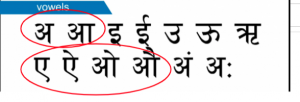
We are focusing on the vowels circled in red for today’s lesson. We are learning the “independent” vowel form, as there is a corresponding “dependent” vowel form for when these vowel sounds follow a consonant. That will be a “next lesson” endeavor.
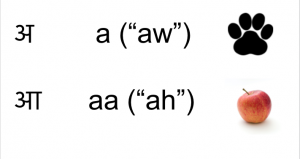
Practice pronouncing अ and आ. What is in quotations is how you can think of how it is pronounced. The images are a word pronunciation association to help you. For example, अ is pronounced “aw” like in the word paw, whereas आ is pronounced “ah” as in apple.
Cover up the pronunciation hints and practice your pronunciation without help. Next, cover up the Devanagari and practice writing the letters. We will repeat this with the next four vowels.
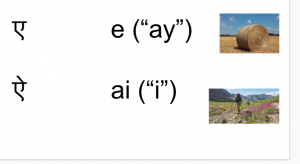
Practice pronouncing ए and ऐ. See the visual aids for pronunciation. ए is pronounced “ay” as in “hay” and ऐ is pronounced “i” as in “hike.” Do the same practice with pronunciation and writing, with and without help.
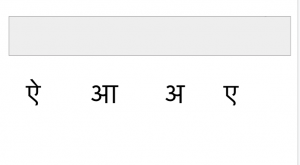 Can you recognize these vowels? Can you say them correctly without looking at your notes? GREAT! Ekdam raamro (very good!) Now, for the last two vowels.
Can you recognize these vowels? Can you say them correctly without looking at your notes? GREAT! Ekdam raamro (very good!) Now, for the last two vowels.
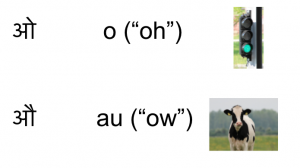
Practice pronouncing ओ and औ. See the visual aids for pronunciation. ओ is pronounced “oh” as in “go” and औ is pronounced “ow” as in “cow.” Do the same practice with pronunciation and writing, with and without help.
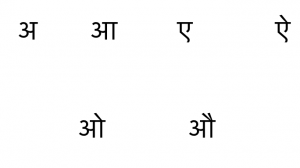 Now practice pronouncing all 6 vowels without help. Go out of order to see if you remember! You may also practice writing them once you have the pronunciation down. Great job!!! Now you know how to write and speak 6 independent vowels in Nepali Devanagari. Here is the link to the full PowerPoint presentation. https://docs.google.com/presentation/d/10ePAes8iX3VEnagMTjqY9UiqUgBfqfNzg5lA2qZaAyk/edit?usp=sharing
Now practice pronouncing all 6 vowels without help. Go out of order to see if you remember! You may also practice writing them once you have the pronunciation down. Great job!!! Now you know how to write and speak 6 independent vowels in Nepali Devanagari. Here is the link to the full PowerPoint presentation. https://docs.google.com/presentation/d/10ePAes8iX3VEnagMTjqY9UiqUgBfqfNzg5lA2qZaAyk/edit?usp=sharing
Beginner Phrases: Follow along with audio here.
Namaste/Namaskar नमस्ते / नमस्कार | Hello (familiar) / Hello (respect)
Mero naam Sam ho. मेरो नाम साम हो | My name is Sam.
Wahaako naam Ram ho. वहाँको नाम राम हो | His/Her (high respect) name is Ram.
Tapaiko naam ke ho? तपाइको नाम के हो | What is your (high respect) name?
Tapaiko naam Sam ho? तपाइको नाम साम हो ? Your name is Sam?
Ho. Mero naam Sam ho. हो मेरो नाम साम हो | Yes, my name is Sam.
Hoina. Mero naam Ram ho. होइन मेरो नाम राम हो | No. My name is Ram.
Wahaako naam ke ho? वहाँको नाम के हो ? What is their name?
Wahaako naam Ram ho. वहाँको नाम राम हो | Their name is Ram.
Yo ke ho? यो के हो ? What is this?
Yo kalam ho. यो कलम हो। This is a pen.
Yo jhola ho. यो झोला हो। This is a bag.

